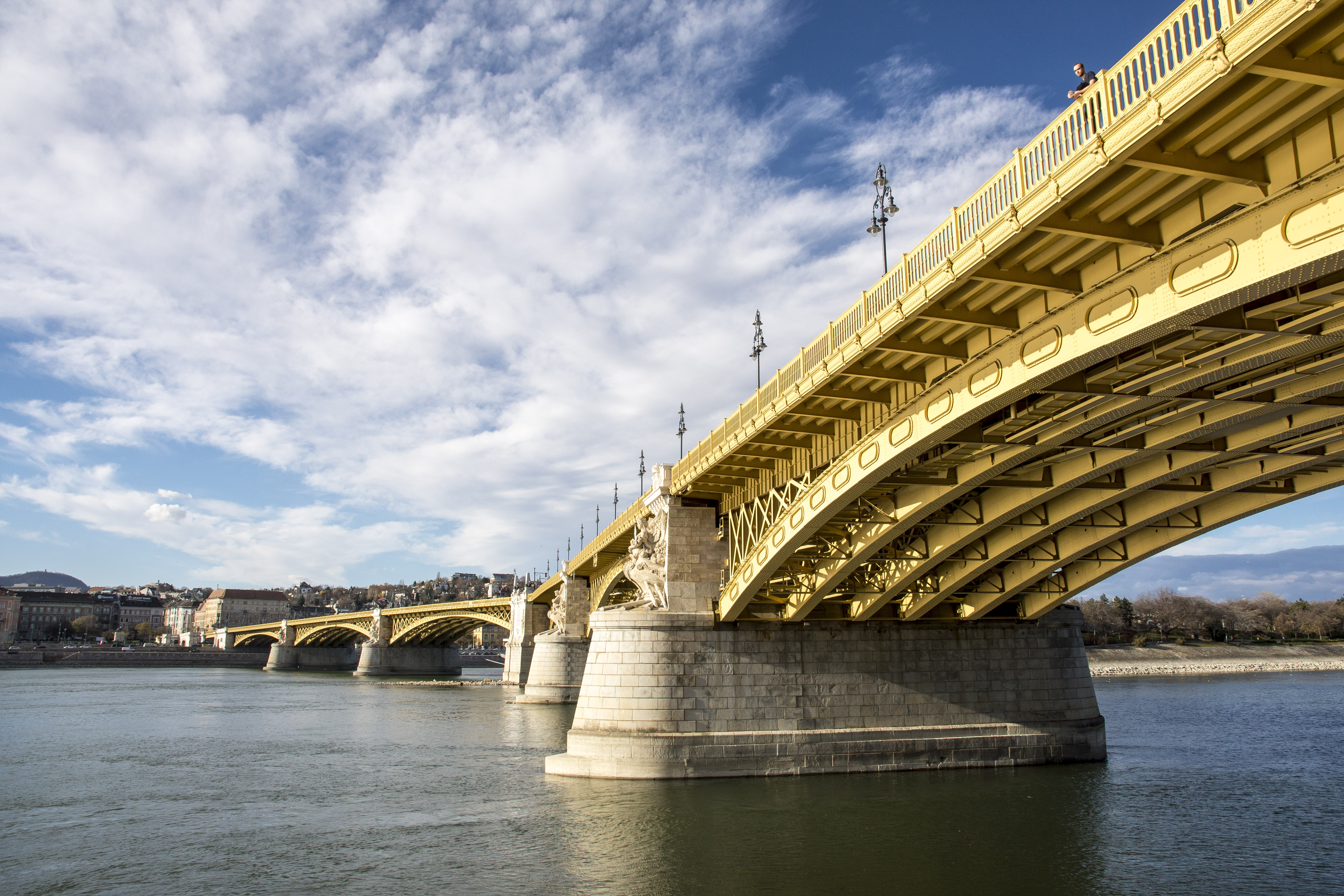Whether admiring the city skyline from the middle of their walkways or gazing at their majestically suspended roadways from the riverbanks, the Danube crossings of Hungary's capital are always eye-catching. The bridges are each a sight to behold for their design and engineering beauty, but they also provide plenty of lookout points to see Budapest from multiple perspectives. Here we take a look at the city's five most central bridges and the monumental attractions that surround them, complemented by some scenic Instagram photos and some recommendations for picture-perfect places to visit nearby both sides of each span.
While connecting Pest and Buda, Margaret Bridge forms a “Y” shape to also provide access to Margaret Island, and from this juncture looking south, viewers enjoy one of the city's most picturesque vistas, encompassing the Parliament House, the Chain Bridge, Gellért Hill and the Liberation Monument, and the entirety of Castle Hill. However, the second oldest bridge in Budapest is also quite attractive in and of itself, featuring numerous stone statues visible from both banks and the northern tip of Margaret Island. Opened in 1876 according to the plans of French engineer Ernest Gouüin, it was completely destroyed in the final months of WWII by retreating German troops. Rebuilt in 1948, further renovations were made in the '70s, and then again in 2011. In 2014 the finishing touches were completed, finally restoring it to the ornamental charm of the pre-war bridge.
On the Pest side, Margaret Bridge marks one end of Budapest’s main thoroughfare – the Grand Boulevard, which we described in this article. The span is anchored to Jászai Mari Square, and from here it is just a few minutes' walk past the galleries of Falk Miksa Street to the Parliament, or take a stroll along the waterfront to the newly refurbished Olimpia Park, which provides sweeping views over Margaret Bridge and the Buda Hills. On the Buda side, the crossing concludes nearby Bem Square on the waterfront, which provides a nice perspective over Margaret Bridge and the Parliament. Alternatively, walk a few meters from the bridge's ending along Frankel Leo Street and then up a steep cobblestoned lane to find Gül Baba’s tomb, which also offers a unique panorama.
Day or night, the Chain Bridge is the crowning centerpiece of Budapest's riverscape. As the Danube's first permanent crossing, it was constructed in 1849 to immediately become one of Hungary's most recognizable landmarks, enhanced by its position directly beneath the towering dome of the Royal Palace atop the Buda Castle, as well as the regal Sándor Palace and the colorfully tiled roof of the Matthias Church. Meanwhile, the suspension bridge's Pest side runs directly towards the Art Nouveau grandeur of the Four Seasons Hotel Gresham Palace, while the nearby Hungarian Academy of Sciences is also a stately sight. On the bridge itself, four stone-carved lions guard both Chain Bridge entrances, and the intricately hewn arched support towers look amazing when illuminated by myriad bulbs after sundown.
Perhaps the best views over the crossing itself are provided during the short-but-steep ride up the Castle Hill Funicular, although the recently renovated Clark Ádám Square also affords an imposing perspective over the adjacent Chain Bridge, and nearby, the freshly renewed Várkert Bazaar features several stunning overlooks toward the imposing span. On the Pest side, the Chain Bridge ends just a few steps away from the panoramic Danube Promenade and the popular Spoon riverboat eatery, where the view over this historic crossing is as central to the dining experience as the meals.
Stunning in its simplicity, the white Elizabeth Bridge was originally opened in 1903 as an astounding engineering feat for its suspension design. Along with the rest of the city's spans, it was also blown up during WWII's concluding tragedies, but it was rebuilt in its current form by 1964. While this crossing may lack the statuesque intricacy of the aforementioned bridges, its imposing position beside Buda's Gellért Hill and the way that it runs directly into the heart of Pest's most bustling avenue offers plenty of impressive visuals. In addition, the scenery is particularly enjoyable when looking north from the center of this long span, offering a balanced view of Buda Castle's attractions, the Chain Bridge's entire length, and Pest's riverfront palaces, while the radio towers of Hármashatár Hill reach skyward far in the distance.
For the best views over Elizabeth Bridge from the Pest side, relax on the green grass at the recently revamped March 15 Square. Nearby, tree-shaded Petőfi Square is the southernmost point of the Danube Promenade, and here the entire span is also overwhelmingly beautiful. Nonetheless, the views over Elizabeth Bridge are unbeatable from Buda's myriad belvederes of Gellért Hill, and those who climb the winding stairs up to the Citadel are rewarded with awe-inspiring views over not only this bridge but also the entire Magyar metropolis. The newly upgraded Rudas Bath now features a rooftop hot tub that is an especially relaxing place to admire the soaring white towers of this breathtaking crossing.
Emperor Franz Joseph pressed the button that hammered the final silver rivet into the Liberty Bridge in 1896 as part of Hungary's Millennium celebrations, and this grandly designed span is indeed a symbol of pride in Budapest history. Topped by statues of patriotic Turul birds and embellished with the national seal at the central apex of each tower, this intricately constructed green masterpiece is a favorite of many locals, and a significant place for many young couples as evidenced by the many padlocks fastened on its railings, with each partner taking a key. It is easy to imagine the lovers standing here during this romantic interlude, admiring the northward views toward the Elizabeth Bridge and Castle Hill looming upriver as boats pass directly beneath.
The beauty of this bridge can also be admired from a nearby lookout point on Buda's lower section of Gellért Hill, while many guests in the adjacent Hotel Gellért enjoy great vistas of the bridge directly from their windows. On the Pest side, the bridge reaches Fővám Square by the Great Market Hall and the beautiful Corvinus University building. A panoramic walkway leads to the Bálna Budapest, but make sure to turn back and admire the view of the Liberty Bridge with Gellért Hill rising behind it.

Despite being named after Sándor Petőfi – the nation's most cherished poet, whose powerfully written prose helped inspire Hungary's 1848 Revolution – Petőfi Bridge is anything but a beautiful conduit, with its current incarnation dating back to the 1950s and reflecting the utilitarian aesthetic tastes of that era under communism. However, from the center of this span we can look north to appreciate a broad perspective over downtown Budapest with distant hills for a backdrop, while the southbound views encompass such contemporary structures as the Rákóczi Bridge, the National Theater (with its riverfront architecture designed to resemble a ship), and the mammoth Palace of Arts, which is enlivened with a sparkling light show every night of the week.
On the Pest side, Petőfi Bridge meets the Boráros Square transport hub and continues on as the Grand Boulevard, which winds its way through the inner city all the way back to Margaret Bridge. Back on the Buda side, the world-renowned A38 party ship offers the best views possible over Petőfi Bridge, which somehow becomes ever-more beautiful with every cocktail consumed on the deck-top bar.








